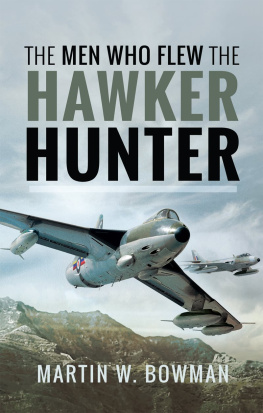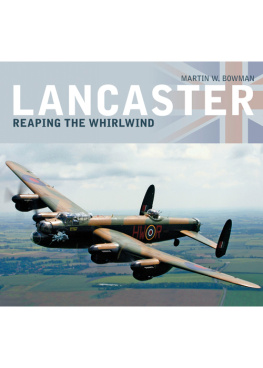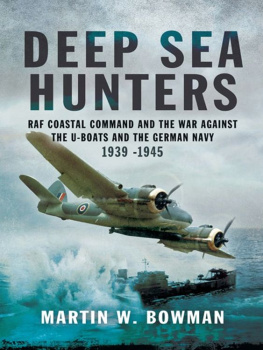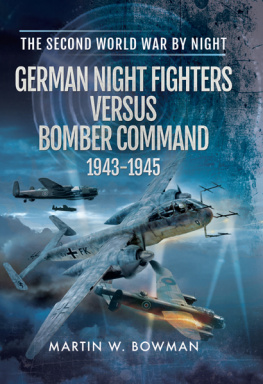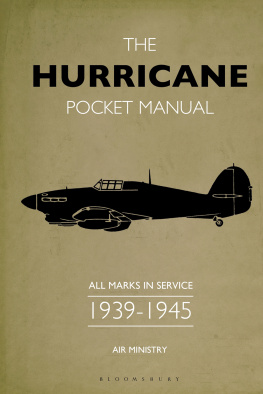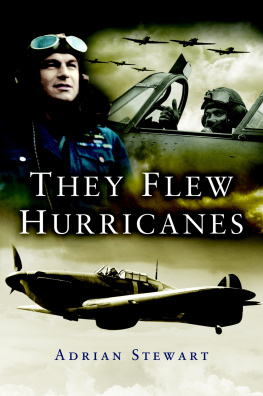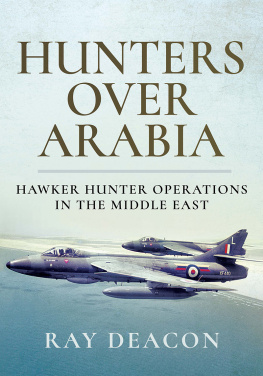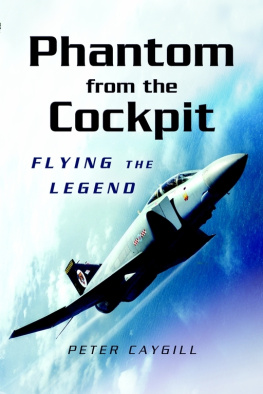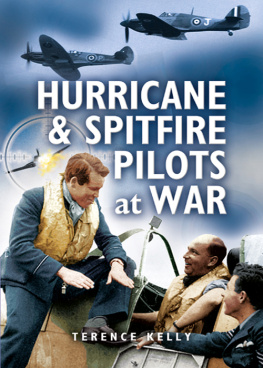Pagebreaks of the print version

THE MEN WHO FLEW THE
HAWKER HUNTER
THE MEN WHO FLEW THE HAWKER HUNTER
MARTIN W. BOWMAN
First published in Great Britain in 2021 by
PEN AND SWORD AVIATION
an imprint of
Pen & Sword Books Limited
Yorkshire Philadelphia
Copyright Martin W. Bowman, 2021
ISBN 978 1 52670 572 3
eISBN 978 1 52670 574 7
The right of Martin W. Bowman to be identified as the author of this work has been asserted by him in accordance with the Copyright, Designs and Patents Act 1988.
A CIP record for this book is available from the British Library All rights reserved. No part of this book may be reproduced or transmitted in any form or by any means, electronic or mechanical including photocopying, recording or by any information storage and retrieval system, without permission from the Publisher in writing.
Pen & Sword Books Ltd incorporates the imprints of Pen & Sword Archaeology, Atlas, Aviation, Battleground, Discovery, Family History, History, Maritime, Military, Naval, Politics, Railways, Select, Social History, Transport, True Crime, Claymore Press, Frontline Books, Leo Cooper, Praetorian Press, Remember When, Seaforth Publishing and Wharncliffe.
For a complete list of Pen and Sword titles please contact
PEN & SWORD BOOKS LTD
47 Church Street, Barnsley, South Yorkshire, S70 2AS, England
E-mail:
Website: www.pen-and-sword.co.uk
Or
PEN & SWORD BOOKS
1950 Lawrence Rd, Havertown, PA 19083, USA
E-mail:
Website: www.penandswordbooks.com
Acknowledgements
George Aird; Alastair Aked; Tony Aldridge; Brian Allchin; Air Commodore G. Max McA. Bacon; Adrian Balch; Pat Barker; Chris Bassham; Alan Beaumont D. Phil; Squadron Leader Kenneth Becker; Lawrence R. Bedford; Ian Bell, Tangmere Military Aviation Museum; Roy Braybrook; Adrian Brown; Ken Bullard; Ian Cadwallader; Squadron Leader Peter Carr; Fred Cattermole; Carole and Dennis Charlton; Bob Collis; Bob Cossey; Ray Deacon; Larry DEath; Wing Commander R. J. F. Dickie Dickinson; John Farley; Bern Flower; AVM Mike Gibson CB OBE ; AVM Sam Goddard; Val Grimble; David Grimer; Val Guest; Eric G. Hayward; Ken Hazell; Sheila Hamilton; Mike Haggerty; Group Captain Alan Hastings OBE ; Group Capt Mike Hobson CBE AFC ; Wing Commander Gerry Honey OBE ; M. J. Hornagold; Geoff Hurst; Roger Hymans; Mick Jennings MBE ; Ben Jones; David Jones; Dave Ketteringham; Terry Kingsley: Chris Lampard; Geoffrey H. Lee; Ted Liddell; Roger Mansfield Philip Markham; the late Francis K. Mason BS c FRH ist S FCGA FACA AMRA e S , for his advice and kind permission to quote from his book; Squadron Leader Bernard J. Noble, who very kindly granted me permission to quote from his book, Noble Endeavours (Three Generations of RAF Pilots , privately published in 1998); Alan Pollock; Wing Commander Stuart G. Pountain; Franios Prins; Brian Ralph; Laurie Reid; Bernard Reynolds; Paul Richardson; Richard D. Rix; AVM Boz Robinson; Jack Rowe BEM ; Bruce Rust; Duncan Simpson OBE C . E ng FFIM ech E FRA e S ; Colin Smith; Dave Stint; Vic A. Terry; Andy Thomas; Michael Thomas; Air Commodore Roger Topp AFC **; Tom Trower; R. Twell; Tim Webb; Neal Wharton and Richard Wilson.
I would especially like to thank Susan Mercer for her kind permission to quote from her late husbands book, Black Arrow Blue Diamond: Leading the Legendary RAF Flying Display Teams by Brian Mercer AFC * M i D published by Pen & Sword Aviation in 2006.
Chapter 1
Hunter Hysteria
there has been a tendency to bestow a personality upon the machine; this is only really credible when bestowed by the men who built and flew it. The Hunter has been a long-serving and faithful workhorse, a beast admired and respected by most and perhaps hated by a few. It certainly had its tribulations in its early days, now almost forgotten, but these were overcome they had to be, for after the disastrous eclipse of the Supermarine Swift, the Hunter was the only British fighter on the horizon.
Certainly as time passed this very beautiful aeroplane began to acquire a kind of charisma. It was as if the meticulous design treatment by the dedicated team, led by a man who possessed a unique appreciation of beauty and grace in the flying machine, was being reflected in the behaviour of the Hunter. The pilots quickly learned how to get the best from their aeroplanes and became their staunch advocates. And long after individual aircraft had passed their predicted fatigue life (the threescore years and ten of the aeroplane), Hunters were being painstakingly refurbished and sent into the air again. There are numerous instances in which individual Hunters have flown with three or four different air forces of the world and at least one has flown with no fewer than seven! Little wonder that something of a mystique can be detected in the character of the Hunter. In at least one air force Hunters served for almost fifty years before being finally retired. Unquestionably this will not be matched by any other front-line aeroplane in history.
Francis K. Mason
British fighters had been among the worlds finest during World War Two. Many of them, such as the Hawker Hurricane and the Typhoon rocket-firing fighter, were the result of the design teams headed by Sydney Camm, born on 5 August 1893; a man who had been Hawkers chief designer since 1925. During his employment at Hawker he was responsible for the creation of 52 different types of aircraft, of which a total of 26,000 were manufactured. Among his early designs were the Tomtit, Hornbill, Nimrod, Hart and Fury. At one time in the 1930s 84 per cent of the aircraft in the RAF were of Camm design. His greatest post-war creation, the Hunter, beckoned, but bringing this project (and others) to fruition would prove difficult. In 1945 Britain had emerged impoverished and austere from five years of war while the United States and the Soviet Union gained new dominance, both politically and militarily. British politicians tried forlornly to resuscitate and transform the economy but deprivation and sacrifice could not be remedied overnight or even over a period of years. America gave Europe aid, but Britains overall economic situation, in the aviation industry certainly, was one of under investment and low priority. Make do and mend, an attitude reminiscent of the period immediately after the First World War, was the order of the day.
America had no such military aircraft replacement problems and her aviation industry, profiting hugely with data from captured secret German jet designs and advanced wing technologies, forged ahead with second-generation jet fighters and bombers. In Britain innovative design and aircraft production went largely un-rewarded and under-funded. When the Government did get involved, generally it was to meddle and confuse the situation. Fortunately, British aircraft designers and engine makers had lost none of their genius and invention - far from it. At their companies expense, they began producing advanced commercial and military designs that would compete with and in many cases beat, the rest of the world. The onset of the Cold War between east and west, first with the Soviet Blockade of Berlin in 1948 and then war in Korea, which began in 1950, concentrated minds wonderfully on both sides of the Atlantic. (America would later fund production and deliveries of aircraft like the Hunter, to nations outside the Communist Bloc.) Churchill and the Conservatives were returned to power in 1951 and the climate began to change from austerity to more sunlit uplands whose warm glow lit up the design offices and production lines of Hawker, de Havilland, Gloster and Supermarine, to name but a few.

